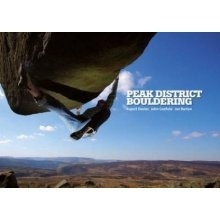Guidebook: Peak District Bouldering
21st Jul 2011
This is the first of a series of guidebook reviews to come over the next few weeks.
Peak District Bouldering is the second edition of the popular Vertebrate Publishing Guide. VP are based in Sheffield and are a part of Vertebrate Graphics, responsible for a great many of the climbing publications, adverts and websites that we have seen over the years. The team is lead by Jon Barton and John Coefield, both incredibly keen boulderers. When I chaired the Peak Area Committee for three years I don't ever recall going to a meeting and not seeing Mr Coefield there, that's how dedicated he is to his sport. As a result the guide is a thoroughly professional mix of style and knowledge.
First thing's first. It's a striking cover shot, though I am sure some will bemoan the fact that you can't really identify the face of the climber (Dave Norton on Low Rider at Stanage). This image sets the tone for the rest of the book which contains a reasonable number of well taken and inspiring shots. The topo shots are also well composed, with clearly defined white arrows marking the problems. My issue with the photos is an age-old guidebook writer's nightmare. To include the grade and page number or not? This guide chooses not to, a disappointment in my eyes.
Whilst we are on negatives there are a few other minor points. The general text is pretty small (I guess this is a positive given that the guide is a whopper at 488 pages, meaning there are a LOT of problems described). However there is a sizeable white border running along the length of the top of each page. Maybe a bigger point size and less empty space? The guide lacks a ribbon to mark the page you are on. Not an essential guidebook feature, but one highlighted by the thin black line that runs down the inside edge of each page and looks very much like a ribbon! My biggest complaint though, is the format. It seems that all bouldering guides these days are landscape. Whilst I appreciate that this means better photographs, it also means a shorter spine and longer pages, which are less manageable, especially in the wind. Personally I would like to see a return to portrait format guides that you can use in one hand. That said, this doesn't detract from the content or quality of the guide at all.
OK, that's about all I can find wrong with the guide. As if John and Jon weren't up to the job of editing the guide, they have been joined on the team by local bouldering guru Rupert Davies - is there anything this man doesn't know about Peak Bouldering? As a result it is literally jam packed with problems. By Rupert's own admission in the brief introduction there are more of highballs described than ever before, a reflection of the fact that boulderers are now happier to approach a problem with a large collection of pads and spotters. Interestingly there are limestone crags described, but the majority of the guide is given to gritstone.
Any visiting climber will surely not be disappointed with the purchase (£25). Foreword by Ben Moon.

